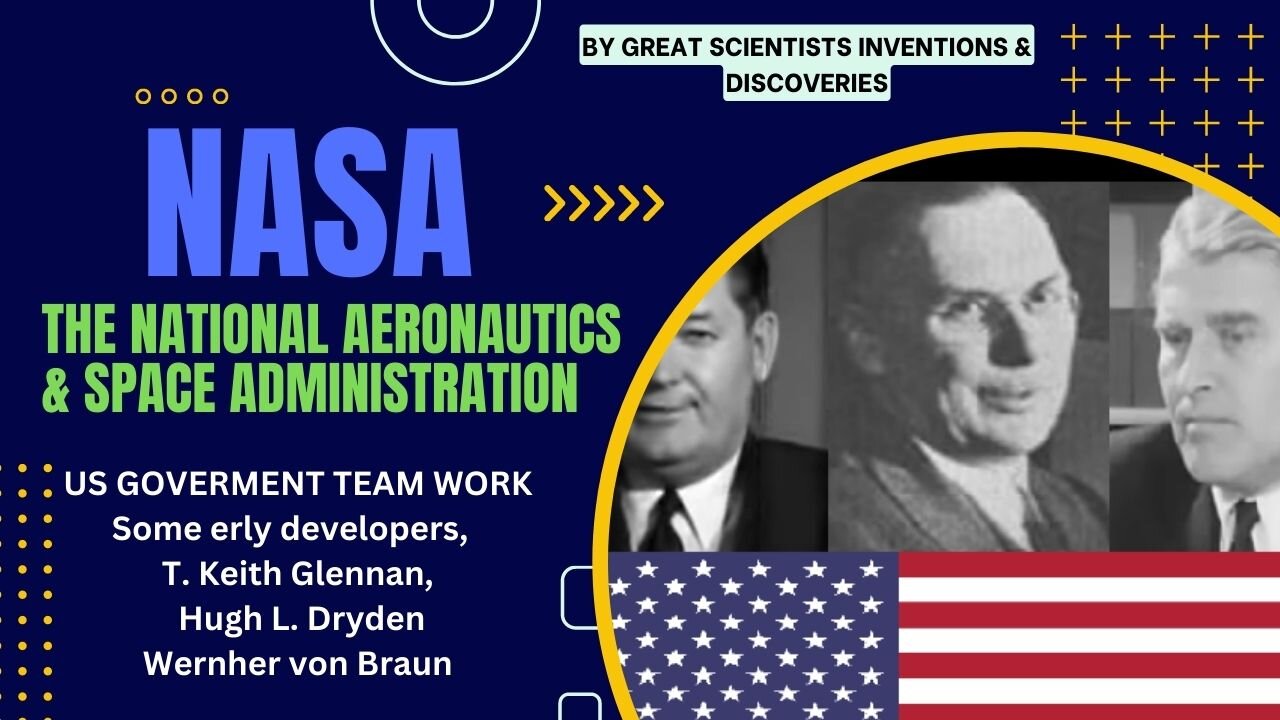Premium Only Content

NASA - FOUNDER TEAM WORK -USA GOVERNMENT
The National Aeronautics and Space Administration (NASA) is the United States government agency responsible for the nation's civilian space program and for aeronautics and aerospace research. It was established on July 29, 1958, by the National Aeronautics and Space Act. NASA's mission is to explore space, conduct scientific research, and develop new technologies in the fields of space exploration and aeronautics.
Some of NASA's key accomplishments and activities include:
Apollo Program: NASA's Apollo program achieved the historic Moon landings, with Apollo 11 being the first mission to successfully land astronauts on the Moon in 1969.
Space Shuttle Program: The Space Shuttle program (1981-2011) involved reusable space vehicles that carried astronauts and cargo to and from space. The shuttles played a vital role in constructing the International Space Station (ISS).
International Space Station (ISS): NASA, in collaboration with international partners, has been involved in the design, construction, and operation of the ISS, a large habitable space station orbiting Earth for research and international cooperation.
Mars Exploration: NASA has sent several robotic missions to Mars, including rovers like Spirit, Opportunity, Curiosity, and Perseverance, to study the planet's geology, climate, and potential habitability.
Hubble Space Telescope: Launched in 1990, the Hubble Space Telescope has provided breathtaking images and invaluable data about the universe, helping scientists to better understand distant galaxies, stars, and cosmic phenomena.
Planetary Exploration: NASA has explored various planets and celestial bodies within our solar system using robotic missions. Missions like Voyager, Cassini, and Juno have provided insights into the nature of other planets and their moons.
Earth Science: NASA conducts research and missions to study Earth's climate, atmosphere, oceans, and ecosystems. This data helps scientists understand climate change, natural disasters, and environmental trends.
Aeronautics Research: NASA's aeronautics research has contributed to advancements in aviation technology, safety, and efficiency, leading to innovations in aircraft design and air traffic management.
Artemis Program: NASA's Artemis program aims to return humans to the Moon by the mid-2020s, focusing on sustainable lunar exploration and preparing for future crewed missions to Mars.
James Webb Space Telescope: Set to launch soon, the James Webb Space Telescope is the successor to the Hubble Space Telescope. It will observe the universe in infrared wavelengths and provide insights into the early universe, star formation, and exoplanets.
These are just a few highlights of NASA's extensive history and ongoing activities. The agency collaborates with international space agencies, research institutions, and private companies to advance scientific knowledge and human exploration beyond Earth's boundaries.
-
 9:05
9:05
Bearing
1 day agoJaguar's Woke New Ad is SHOCKINGLY Bad 😬
27.8K104 -
 7:55
7:55
Chris From The 740
16 hours ago $9.66 earnedWill The AK Project Function - Let's Head To The Range And Find Out
21.7K9 -
 2:39
2:39
BIG NEM
12 hours agoHygiene HORROR: The "Yurt Incident"
14.4K2 -
 3:19:21
3:19:21
Price of Reason
16 hours agoHollywood Celebrities FLEE the US After Trump Win! Wicked Movie Review! Gaming Journos MAD at Elon!
104K66 -
 3:55:45
3:55:45
Alex Zedra
11 hours agoLIVE! Last Map on The Escape: SCARY GAME.
88.3K3 -
 1:14:07
1:14:07
Glenn Greenwald
16 hours agoComedian Dave Smith On Trump's Picks, Israel, Ukraine, and More | SYSTEM UPDATE #370
184K271 -
 1:09:07
1:09:07
Donald Trump Jr.
18 hours agoBreaking News on Latest Cabinet Picks, Plus Behind the Scenes at SpaceX & Darren Beattie Joins | TRIGGERED Ep.193
223K778 -
 1:42:43
1:42:43
Roseanne Barr
14 hours ago $65.93 earnedGod Won, F*ck You | The Roseanne Barr Podcast #75
101K214 -
 2:08:38
2:08:38
Slightly Offensive
15 hours ago $43.01 earnedDEEP STATE WINS?! Matt Gaetz OUSTED as AG & Russia ESCALATES War | Guest: The Lectern Guy
97.3K62 -
 1:47:36
1:47:36
Precision Rifle Network
15 hours agoS3E8 Guns & Grub - the craziness continues
72.9K4